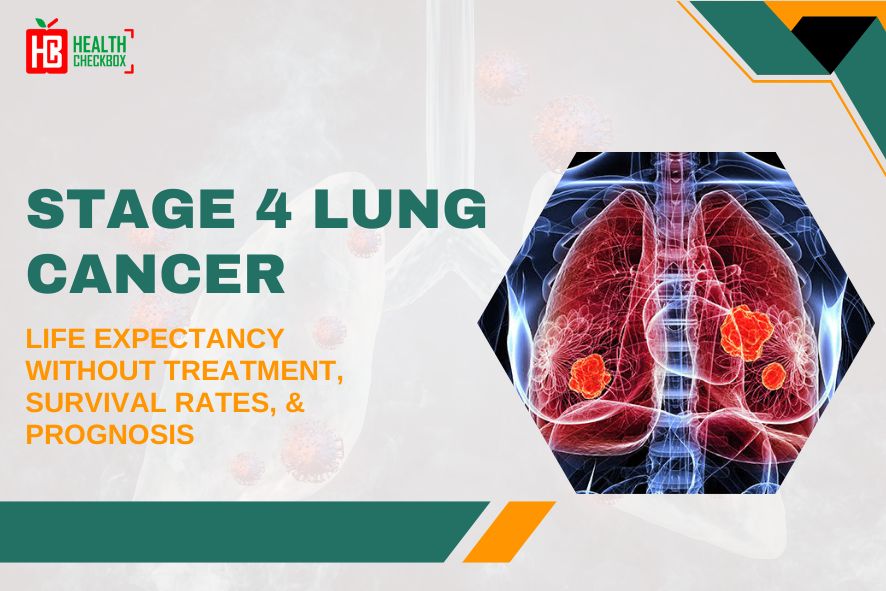Lung cancer which is in a progressive stage, and has spread from the main tumor cells to nearby organs, has a low rate of survival. This is because lung cancer treatment becomes harder to treat as it advances. In this blog, we discuss the life expectancy for stage 4 lung cancer without treatment and the various factors that might affect the prognosis after diagnosis.
While the statistical data may not reveal the true figures, it is crucial to remember that stage 4 lung cancer does not follow a predetermined path. Many individuals will survive for months and even years beyond this. Indeed, numerous factors can affect survival durations, with some of them, such as smoking, being adjustable. Modern cancer treatment and immunotherapies are assisting individuals with stage 4 cancer to extend their lives with reduced side effects and improved quality of life.
Lung Cancer Stage 4 Life Expectancy Without Treatment
Patients with this condition, whether or not exposed to asbestos, normally live up to 6.3 months to 11.4 months. This depends on the type of cells and the response to the treatment. Some patients are likely to live longer. These assume the percentage of people who will live for at least 5 years after initial diagnosis. Five-year survival rates are classified as below:
Survival Rates as per TNM Stage
The TNM (Tumour, Node, Metastasis) stage describes how far the cancer has spread to different body parts.
- M1a: 11.4 months
- M1b: 11.4 months
- M1c: 6.3 months
Survival Rates by Extent of Disease
This is another way that estimate the survival rate. The National Cancer Institute’s Surveillance, Epidemiology, and End Results (SEER) Program makes this approach.
- Localized: Cancer restricted to the lungs. And the percentage surviving 5 years after diagnosis is 65%.
- Regional: Cancer that has spread to the surrounding lymph nodes or structures. And the percentage surviving 5 years after diagnosis is 37%.
- Distant: The percentage surviving 5 years after diagnosis is 9%. It means 9% of patients diagnosed with metastatic lung cancer are still alive five years later.
Survival Rates by Type
Five-year survival rates are the normal method to measure the people who are alive 5 years after diagnosis.
- Non-Small Cell Lung Cancer: The National Cancer Institute’s SEER database states that around 7% of non-small cell lung cancer (NSCLC) stage 4 patients have a life expectancy of around 5 years after diagnosis.
- Small Cell Lung Cancer: Around 3% of patients with distant-stage small cell lung cancer live for 5 years following their diagnosis.
The prognostication for Stage 4 lung cancer relies on several factors that include:
- General health,
- Response to treatment,
- Whether the cancer is NSCLC or SCLC.
Survival rates merely provide an estimate. And each person responds uniquely to the treatment. Clinical trials for treatments that are novice, like genetic and immunotherap,y are continuously improving stage 4 lung cancer survival rates.
Factors that Affect the Life Expectancy in Stage 4 Lung Cancer
Without treatment, metastatic lung cancer patients normally live a few months. The exact period varies and depends on:
Types of Stage 4 Lung Cancer
In Stage 4, the cancer cells have spread from their original position to the remaining parts of the body, a process known as metastasis. Stage 4 is subdivided into:
- Stage 4A: The cancer has extended within the lungs or to one location outside the lungs. It can include the other lung, the membranes surrounding the lungs or heart, or a remote lymph node or organ.
- Stage 4B: Cancer has propagated to multiple areas within one or more organs distant from the lungs, including the brain, liver, or bones.
Causes of Stage 4 Lung Cancer
Primarily caused by the same factors that are responsible for lung cancer. Smoking is the main factor and others include:
- Carcinogenic Exposure
- Hereditary Factors
- Secondhand Smoke
- Air pollution and previous radiation therapy to the chest
Symptoms and Signs
Common symptoms of Stage 4 lung cancer include:
- Unaccountable weight loss
- Shortness of breath
- Tiredness
- Lymph nodes that are swollen
Other Factors that Can also Affect
- Tobacco cases: Stopping the intake of tobacco before chemotherapy increases the survival period by at least 6 months as per research published in the Brazilian Journal of Pneumonology.
- Treatment: It is a vital factor and is hard to ignore.
- Age: Another prognostic factor. Aged people have poor outcomes that are poor whatever the stage of the cancer. A person who is below 50 years at the time of diagnosis is more likely to live for a minimum of 5 years as compared to a person who is 65 years or older.
- Sex: Men have a poor outcome as compared to women, predominantly in lung cancer cases.
Diagnosis and Treatment Options for Stage 4 Lung Cancer
Multiple tests are done to diagnose stage 4 lung cancer. These examinations can verify the existence of cancer and ascertain how much it has advanced. Diagnosing stage 4 lung cancer steps include:
- Physical Exam and Medical History: The medical practitioner evaluates risk factors, which include smoking and exposure to asbestos.
- Imaging Procedures: CT and PET scans assist in detecting tumors and the spread of metastasis.
- Blood Tests: Could offer further insights into cancer advancement.
- Biopsy: A tissue sample checks for the presence of lung cancer.
Treatment Options
Palliative care can better comfort and extend life. Many patients choose to forgo treatment, in fear of side effects or reduced quality of life. Regrettably, late-stage lung cancer prognosis is often poor for those who don’t follow treatment. It should be noted that treatment decreases the spread of cancer. Without it, the cancer continues to spread uncontrolled.
Stage 4 cancer is also known as metastatic lung cancer. The cancer has spread from the lung to other parts of the body, so the name was given. If the treatment is not given in the early stage of cancer, it will be crucial to survive. But some treatments can impact survival in stage 4 cancer, which are given below:
- Chemotherapy: It is used as drugs that help to kill cancer cells, which are growing rapidly in the body. Survival rate depends on the types of cancer, but chemotherapy treatment can influence survival by 6 to 12 months.
- Targeted Therapy: The target-specific genetic mutations, such as EGFR, ALK, ROS1, and KRAS, are found in non-small cell lung cancer (NSCLC). This therapy may increase the survival times of patients up to 5 years.
- Immunotherapy: Can immunotherapy cure stage 4 lung cancer? It is a trending question in this era. We are not saying that this therapy will cure lung cancer at stage 4, but this therapy helps to maintain the immune system of the body. If the immune system is good, that helps to destroy cancer cells. The survival time ranges from 2 to 3 years.
Note: As we said before, the survival totally depends on the patient’s health and stage; these therapies are just a treatment to increase the survival.
Can this Lung Cancer be Prevented?
Although Stage 4 lung cancer is not preventable, avoiding tobacco intake and preventing oneself from exposure to carcinogens can make the symptoms less painful and increase a person’s life expectancy. Below are some tips to follow:
- Smoking is a primary risk factor for lung cancer. When you give up smoking, it greatly reduces the risks.
- Different harmful agents, such as asbestos, radon, and air pollution these damage the lungs.
- Eating green, leafy vegetables and fruits, and regular exercise lead to an increase in overall health and a decrease in risk for lung cancer.
Conclusion
Stage 4 NSCLC is an advanced sort of lung cancer. Here, cancer has spread from the lungs to distant organs or areas of the body. Research shows that patients with this type of condition have a five-year relative survival rate of 9%.
While stage 4 lung cancer remains a serious diagnosis, it is important to remember that outcomes are not the same as 20 years ago. Survival rates are an ever-increasing phenomenon, and new medicines can now personalize treatment in ways that were once unheard of.

